- Created by Phillip Hanegan, last modified on Jun 16, 2020
You are viewing an old version of this page. View the current version.
Compare with Current View Page History
« Previous Version 11 Current »
Before connecting EmpowerID to an external directory, please review the Getting Started with Directory Systems topic. The topic walks you through the prerequisites you need to complete before connecting to an external directory for the first time. These prerequisites include: Configuring the appropriate server roles for your EmpowerID servers Reviewing the Join and Provision Rules for your environment Reviewing the Join and Provision Filters for your environment If you have already connected EmpowerID to another external directory, you can skip the above prerequisites. EmpowerID provides connectors for a wide range of user directories and resource systems. As an administrator, you can use these connectors to quickly connect EmpowerID to your organization's identity-aware systems and applications. When you do so, you create an account store for that application in the EmpowerID Identity Warehouse and use that account store to configure how you want EmpowerID to manage the identity information in that system.
EmpowerID Dynamics AX connector allows organizations to bring the user data in their Dynamics AX system to EmpowerID, where it can be managed and synchronized with data in any connected back-end user directories. Once connected, you can manage this data from EmpowerID in the following ways:
Provision new users
Edit user attributes
Delete users
Additionally, EmpowerID provides Provisioning policies or Resource Entitlements (RETs) that allow you to automatically provision DAX accounts for any person within your organization based on your policy requirements. For more information on RETs and DAX, see Creating a Provisioning Policy for Microsoft Dynamics Users.
Prerequisites
In order to connect EmpowerID to Dynamics AX, you need to have a Dynamics AX server with the Dynamics AX client installed. In addition, you need to have the installer for the EmpowerID Dynamics AX Web services. This installer is a separate package that needs to be requested from EmpowerID.
This topic demonstrates how to connect EmpowerID to Microsoft Dynamics AX and is divided into the following activities:
Installing the EmpowerID Dynamics AX Web Services
Connecting EmpowerID to your Dynamics AX User directory
Configuring the Dynamics AX Account Store in EmpowerID
Connecting EmpowerID to your Dynamics AX Worker directory
To install the EmpowerID Dynamics AX Web Service
On your Dynamics AX server, double-click the Dynamics AX WebServices X.X.X.X msi to launch the EmpowerID Dynamics AX Services Setup wizard.
Click Next to begin the installation.
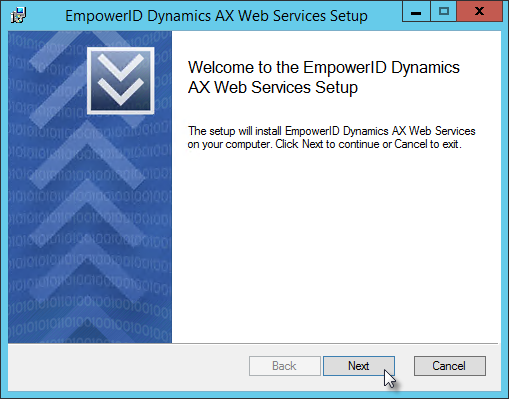
Select the terms of the license agreement and click Next.
Select the destination folder and click Next.
Click Install.
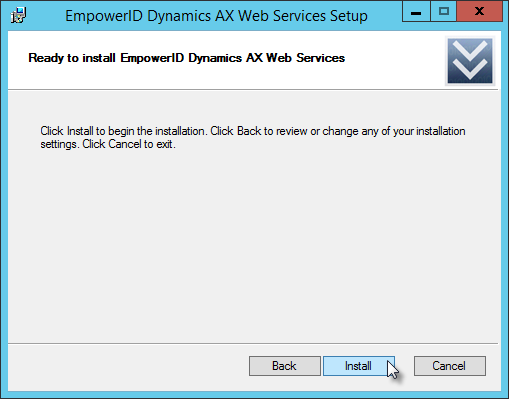
EmpowerID installs the service and opens the EmpowerID DAX Configuration window. You use this window to set the application identity and installation configuration information needed by EmpowerID to communicate with the service.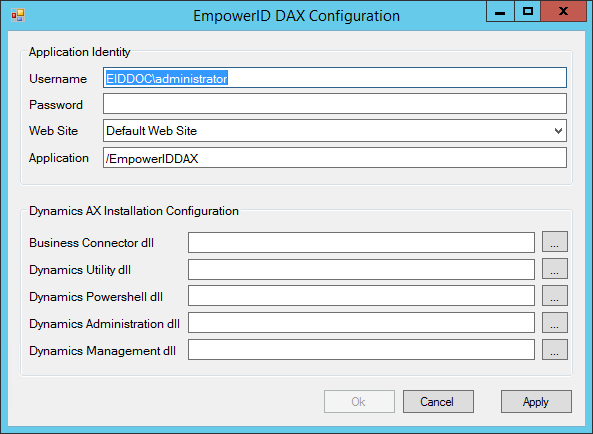
In the Application Identity pane of the EmpowerID DAX Configuration window, do the following:
Type the user name and password of the service identity in the Username and Password fields, respectively. These credentials need to be those of a DAX administrator with read and write permissions to the DAX database.
Select the Web site for the service from the Web Site drop-down. You can keep the default selection or choose another.
Leave the Application field as is.
In the Dyanamics AX Installation Configuration pane of the EmpowerID DAX Configuration window, do the following:
Click the Ellipses (...) for the Business Connector dll field, browse to the bin folder of your Dynamics AX installation (located by default at "C:\Program Files (x86)\Microsoft Dynamics AX\60\Client\Bin") and select BusinessConnectorNet.dll DLL.
Click the Ellipses (...) for the Dynamics Utility dll field, browse to the bin folder of your Dynamics AX installation (located by default at "C:\Program Files (x86)\Microsoft Dynamics AX\60\Client\Bin") and select AXUtilLib.dll.
Click the Ellipses (...) for the Dynamics Powershell dll field, browse to the bin folder of your Dynamics AX installation (located by default at "C:\Program Files (x86)\Microsoft Dynamics AX\60\Client\Bin") and select AXUtilLib.Powershell.dll.
Click the Ellipses (...) for the Dynamics Administration dll field, browse to the bin folder of your Dynamics AX installation (located by default at "C:\Program Files (x86)\Microsoft Dynamics AX\60\Client\Bin") and select Microsoft.Dynamics.Administration.dll.
Click the Ellipses (...) for the Dynamics Management dll field, browse to the bin folder of your Dynamics AX installation (located by default at "C:\Program Files (x86)\Microsoft Dynamics AX\60\Client\Bin") and select Microsoft.Dynamics.AX.Framework.Management.dll.
After completing the above steps, the EmpowerID DAX Configuration window should look similar to the below image.
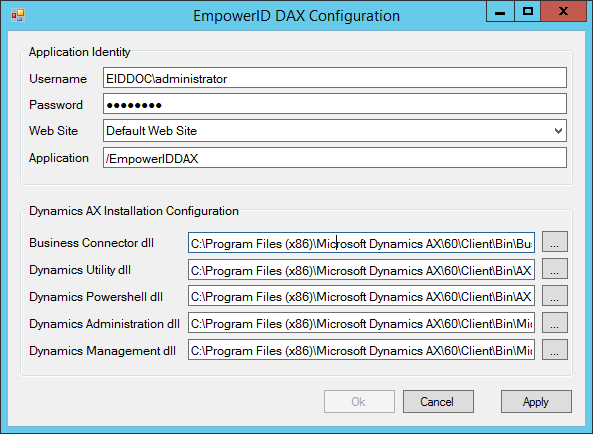
Click Apply and then click Ok to close the window.
After installing the Web service, make note of the service URL. You will need this URL when connecting EmpowerID to your Dynamics AX directories. The default URL is https://YourServerName/EmpowerIDDAX/DAXUserService.svc, where YourServerName is the FQDN of your Dynamics server.
To create an account store for your Dynamics AX User directory
On the navbar, expand Admin, then Applications and Directories, and click Account Stores and Systems.
On the Account Stores page, click Create Account Store.

Search for Dynamics AX User from the list of system types.
Click the record returned for the above query and then click Submit.
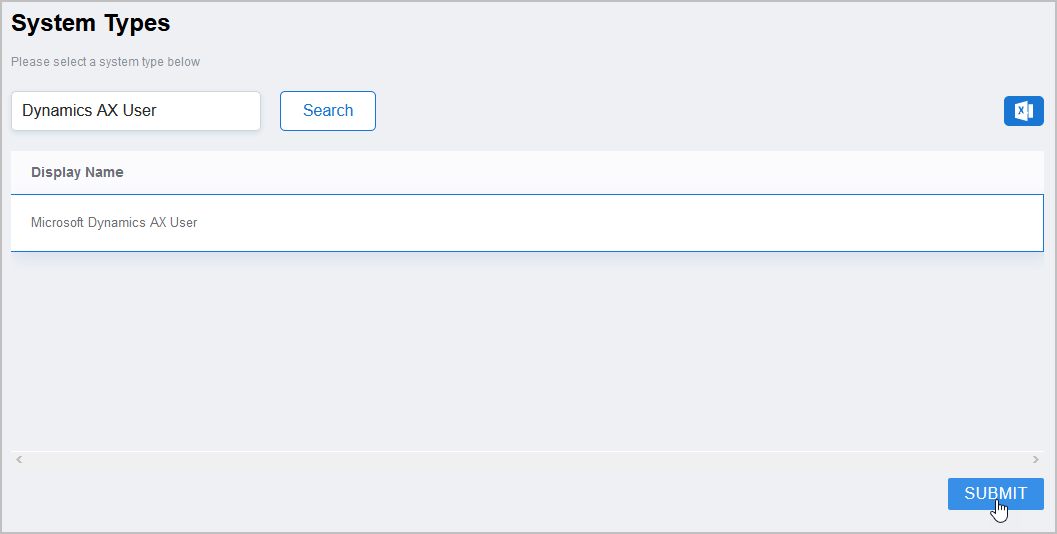
On the DAX User form that appears, enter the following information:
Name — Enter a name for the account store
ServiceURL — Enter the URL for the EmpowerID DAX Web service you installed above. The URL should look similar to:
https://YourServerName/EmpowerIDDAX/DAXUserService.svc, where YourServerName is the FQDN of your Dynamics server.
Click Submit to create the account store.
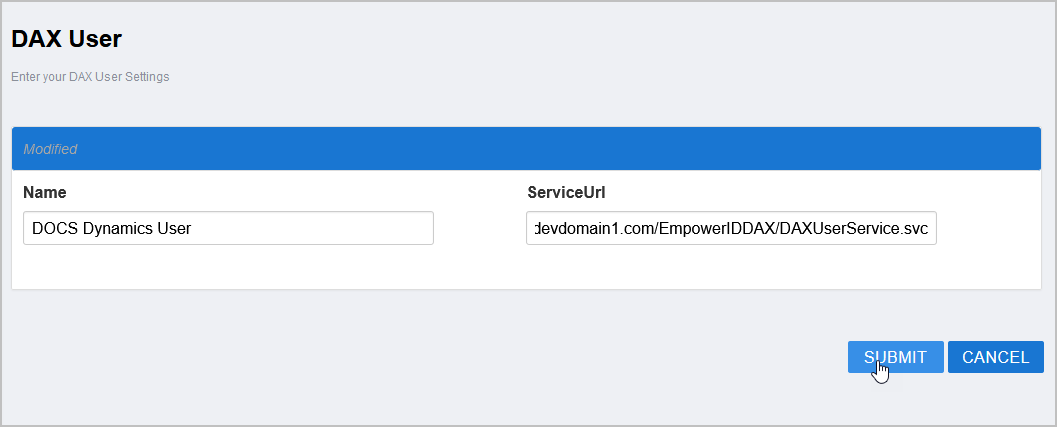
EmpowerID creates the account store and the associated resource system. The next step is to configure the attribute flow between the account store and EmpowerID.
EmpowerID supports the configuration of attribute synchronization rules for flowing attribute changes between directories and the EmpowerID Identity Warehouse. Attribute Flow rules are visually configured and are always relative to the relationship between an attribute in a directory and the corresponding attribute in the EmpowerID Identity Warehouse. Attribute Flow rules define the specific fields and attributes that are synchronized between the EmpowerID Identity Warehouse person objects and the external user accounts to which they are linked. Additionally, Attribute Flow rules can be weighted by account store. For example, if you have connected EmpowerID to an HR system as well as Active Directory, and you want any changes made to an attribute in the HR system to take priority over changes made in Active Directory or EmpowerID (while allowing changes to be made in any system), you would give a higher score for each CRUD operation originating from the HR account store and correspondingly lower scores for the Active Directory account store. The following flow rules are available: No Sync ( Red Circle) — When this option is selected, no information flows between EmpowerID and the native system. Bidirectional Flow (Bidirectional Green Arrow) — When this option is selected, changes made within EmpowerID update the native system and vice-versa. For most attributes, this is the default setting. Account Store Changes Only (Left Pointing Arrow) — When this option is selected, changes can only be made in the native system and are then passed to EmpowerID. EmpowerID Changes Only (Right Pointing Arrow) — When this option is selected, changes can only be made in EmpowerID and are then passed to the native system. The following CRUD operations are available: Create — This operation is used to create an attribute value for an existing attribute when the value of that attribute is null. Update — This operation is used to update the value of an attribute. Delete — This operation is used to delete the value of an attribute. From the Account Stores tab of the Account Stores and Systems page, search for the account store you just created and click the Account Store link for it. Click the Attribute Flow Rules tab to view the current rules for the account store. Please note that the attributes available depend on the account store. To change the flow for an attribute, click the Attribute Flow drop-down located between the Person Attribute column and the External Directory Attribute column, and select the desired flow direction from the context menu. To change the score for any of the available CRUD operations (Create, Update and Delete), enter the new score in the appropriate field. By default, scores are weighted evenly, which means that a change to an attribute originating in one connected external directory has the same authority as a change to an attribute occurring in another connected external directory. EmpowerID only considers scores for attribute CRUD operations when multiple account stores with the same user records are connected to EmpowerID, such as would be the case if an HR System and this account store were being inventoried by EmpowerID.attributeflowrules.mp4
To configure account store settings
On the Account Store and Resource System page, click the Account Store tab and then click the pencil icon to put the account store in edit mode.
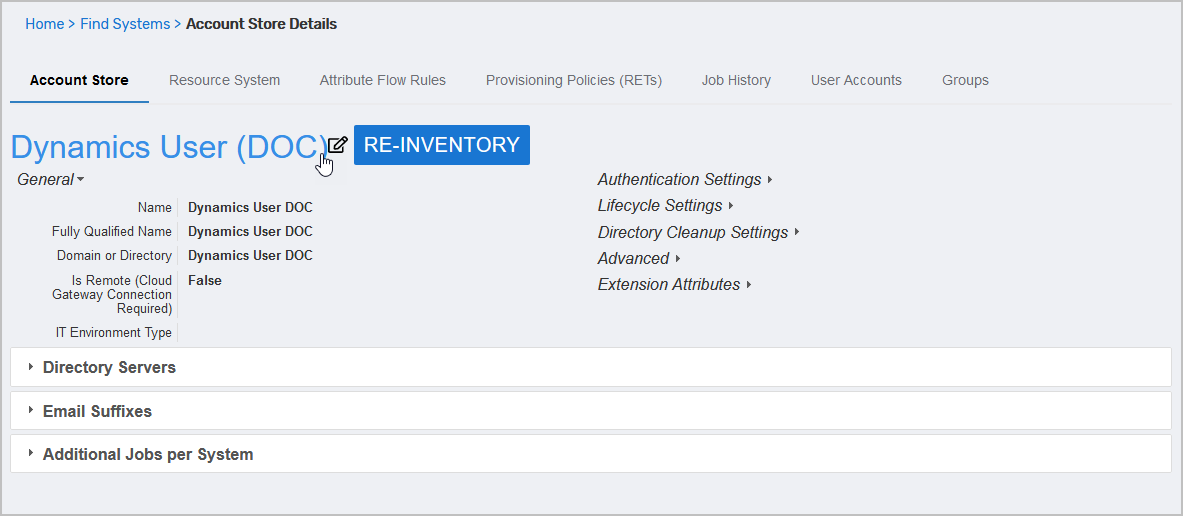
This opens the edit page for the Dynamics User account store. This page allows you to specify the account proxy used to connect EmpowerID to your Dynamics User system as well as how you want EmpowerID to handle the user information it discovers there during inventory. Settings that can be edited are described in the table below the image.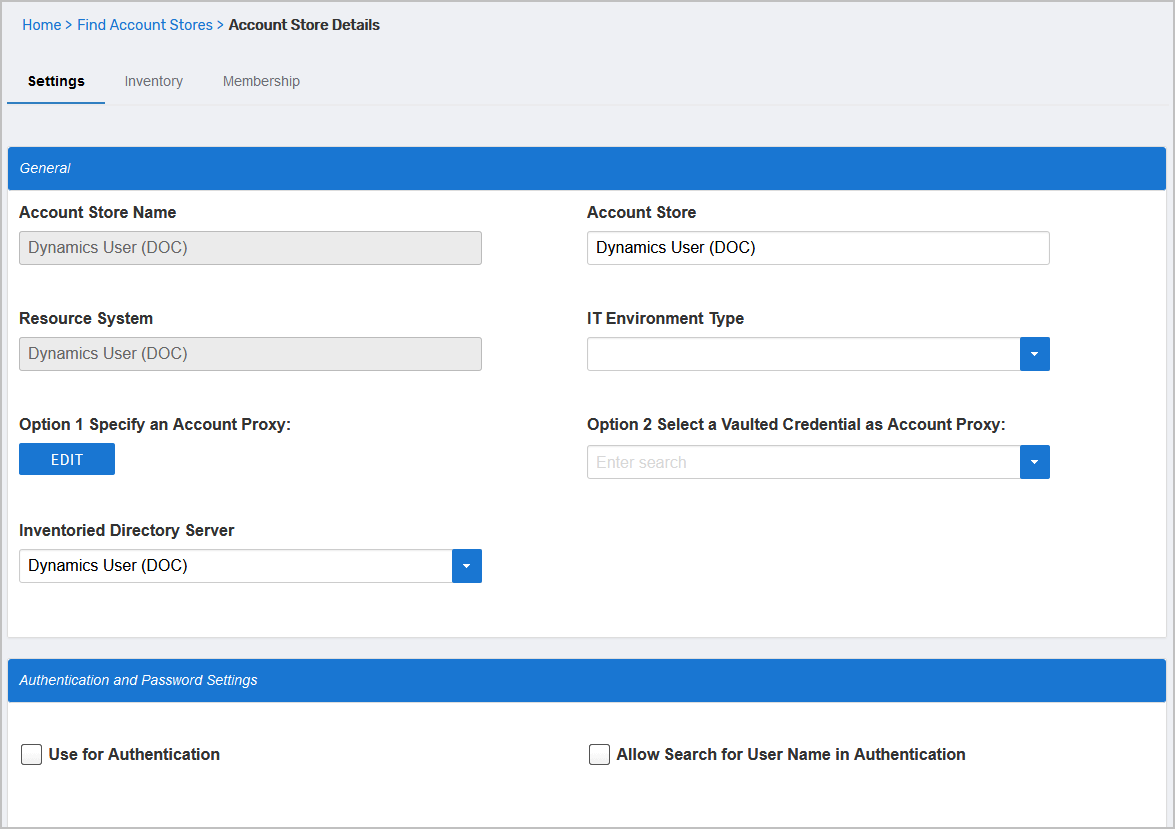
Account Store Settings
Setting
Description
General Settings
IT Environment Type
Allows you to specify the type of environment in which you are creating the account store.
Option 1 Specify an Account Proxy
Allows you to change the credentials for the account that EmpowerID uses to connect to and manage the account store.
Option 2 Select a Vaulted Credential as Account Proxy
Allows you to use a credential that you have vaulted in EmpowerID as the account that EmpowerID uses to connect to and manage the account store.
Inventoried Directory Server
Allows you to select a connected server as the directory server for the account store.
Authentication and Password Settings
Use for Authentication
Specifies whether user credentials in the external system can be used to authenticate to EmpowerID.
Allow Search for User Name in Authentication
This setting works in conjunction with pass-through authentication to allow users to log in without specifying a domain name. When this is enabled, EmpowerID first checks to see if the user name entered exists within its Identity Warehouse and if so attempts to authenticate as that user. If a matching logon name exists but the login fails, EmpowerID then searches through all Accounts Stores where simple username search is enabled to find the correct user name and password combination.
Allow Password Sync
Enables or disables the synchronization of password changes to user accounts in the domain based on password changes for the owning person object or another account owned by the person. This setting does not prevent password changes by users running the reset user account password workflows.
Queue Password Changes
Specifies whether EmpowerID sends password changes to the Account Password Reset Inbox for batch processing.
Password Manager Policy for Accounts without Person
Specifies the Password Manager Policy to be used for user accounts not joined to an EmpowerID Person.
Provisioning Settings
Allow Person Provisioning (Joiner Source)
Specifies whether EmpowerID Persons can be provisioned from user accounts in the account store.
Allow Attribute Flow
Specifies whether attribute changes should flow between EmpowerID and the account store.
Allow Provisioning (By RET)
Allows or disallows the Resource Entitlement (RET) Inbox process to auto-provision accounts for this domain for users who receive RET policy-assigned user accounts, but have not yet had them provisioned.
Allow Deprovisioning (By RET)
Allows or disallows the Resource Entitlement Inbox process to auto de-provision accounts for this domain for users who still have RET policy-assigned user accounts, but no longer receive a policy that grants them a user account in the domain. De-provisioning only occurs if the de-provision action on the Resource Entitlement policy is set to De-Provision.
Max Accounts per Person
This specifies the maximum number of user accounts from this domain that an EmpowerID Person can have linked to them. This prevents the possibility of a runaway error caused by a wrongly configured Join rule. It is recommended that this value be set to 1 unless users will have more than 1 account and you wish them to be joined to the same person.
Allow Account Creation on Membership Request
Specifies whether EmpowerID creates user accounts in the account store when an EmpowerID Person without one requests membership within a group belonging to the account store.
Recertify All Group Changes as Detected
Specifies whether detected group changes should trigger recertification.
Default Person Business Role
Specifies the default EmpowerID Business Role to be assigned to each EmpowerID Person provisioned from the user accounts in the account store.
Default Person Location (leave blank to use account container)
Specifies the default EmpowerID Location to be assigned to each EmpowerID Person provisioned from the user accounts in the account store.
Directory Clean Up Enabled
Directory Clean Up Enabled
Specifies whether the SubmitAccountTermination permanent workflow should claim the account store for processing account terminations. When enabled, accounts in the account store that meet the qualifications to be marked for deletion are moved into a special OU within the external directory, disabled and finally deleted after going through an automated approval process. This process involves setting a number of system settings in EmpowerID and requires multiple approvals by designated personnel before an account is finally removed from the account store.
Report Only Mode (No Changes)
When enabled, a report of what the Directory Clean Up process would do is written to the log. The process itself is ignored and all accounts are set to Termination Pending,
Special Use Settings
Automatically Join Account to a Person on Inventory (Skip Account Inbox)
Specifies whether EmpowerID should attempt to join user accounts in the account store to an existing EmpowerID Person during the inventory process. When enabled, the Account Inbox is bypassed.
Automatically Create a Person on Inventory (Skip Account Inbox)
Specifies whether EmpowerID should create new EmpowerID Persons from the user accounts discovered in the account store during the inventory process. When enabled, the Account Inbox is bypassed.
Queue Password Changes on Failure
Specifies whether EmpowerID should send password changes to the Account Password Reset Inbox only when the change fails.
Inventory Settings
Inventory Schedule Interval
Specifies the time span that occurs before EmpowerID performs a complete inventory of the account store. The default value is 10 minutes.
Inventory Enabled
Allows EmpowerID to inventory the user information in the account store.
Membership Settings
Enable Group Membership Reconciliation
Allows EmpowerID to manage the membership of the account store’s groups, adding and removing user to and from groups based on policy-based assignment rules.
Membership Schedule Interval
Specifies the time span that occurs before EmpowerID runs the Group Membership Reconciliation job. The default value is 10 minutes.
Edit the account store as needed and then click Save to save your changes.
Next, enable the Account Inbox permanent workflow to allow the Account Inbox to provision or join the user accounts in Domino to EmpowerID Persons as demonstrated below.
| AccountInboxPW.mp4
|
On the navbar, expand System Logs > Policy Inbox Logs and click Account Inbox. Dashboard — This tab provides a quick summary of account inbox activity. Not Processed — This tab displays a grid view of all inventoried user accounts not yet used to provision a new EmpowerID Person or joined to an existing Person. Any accounts that fail to meet the Join and Provision rules are displayed here as well. Failed — This tab displays a grid view of any account joining or provisioning failures. Ignored — This tab displays a grid view of all accounts ignored by the account inbox. Accounts are ignored if they do not qualify as user accounts. Joined — This tab displays a grid view of all accounts joined to an EmpowerID Person. Joins occur based on the Join rules applied to the account store. Processed — This tab displays a grid view of all accounts that have been used to either provision a new EmpowerID Person or joined to an existing EmpowerID Person. Provisioned — This tab displays a grid view of all accounts that have been used to provision an EmpowerID Person. Provisioning occurs based on the Provision rules applied to the account store. Orphans — This tab displays a grid view of all user accounts without an EmpowerID Person. All — This tab displays a grid view of all user accounts and the status of those accounts in relation to the Account Inbox.Monitor inventory
The Account Inbox page appears. This page provides tabbed views of all information related to processing new user accounts discovered in a connected account store during inventory. An explanation of these tabs follows.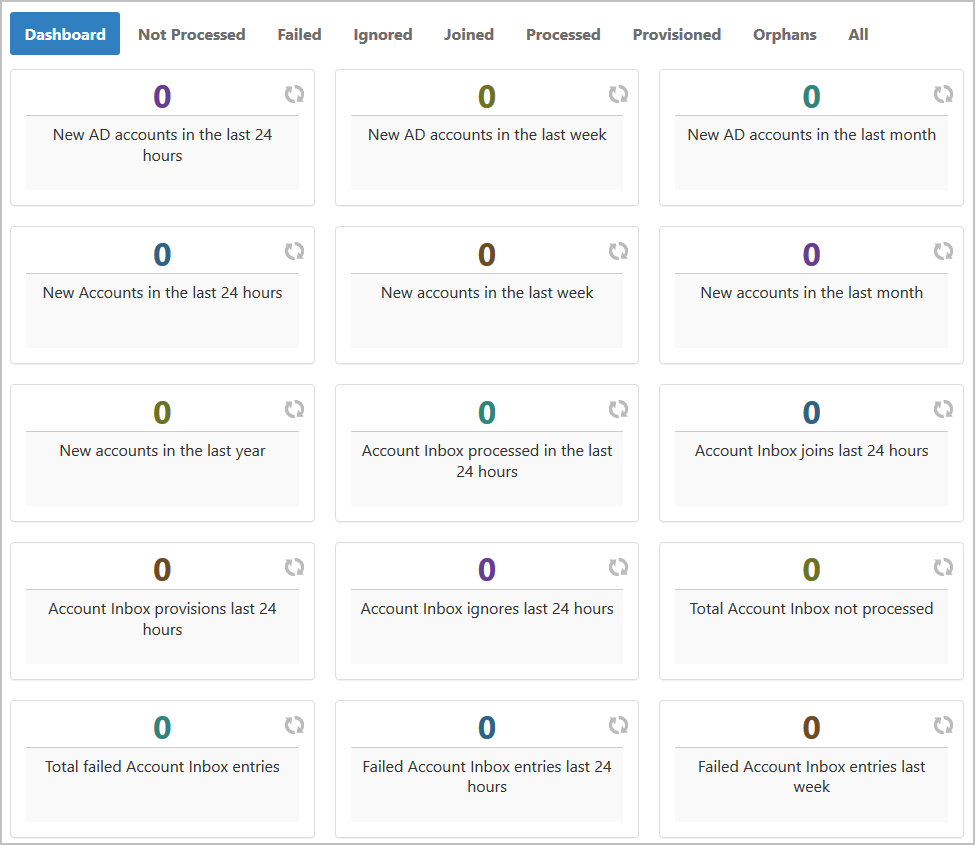
IN THIS ARTICLE
- No labels